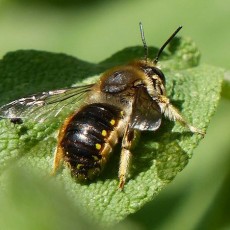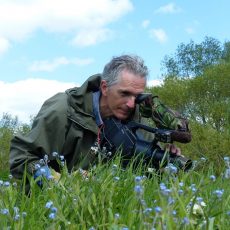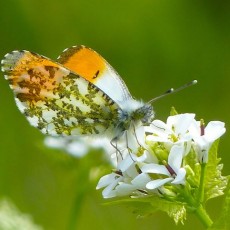“In the middle ages, a lawn was more like a meadow; it was a flowery mead, bursting with perfumed wildflowers and herbs and grasses.” John Lewis-Stempel
The beauty of a wildflower meadow is that it is constantly in a state of change. Nature teaches me to be patient: to wait and see what happens each year. It is beyond my control. Nature teaches me to let-go. Observing the wildflowers and the life that thrives there is a form of meditation, as self is forgotten and is immersed amidst endlessly fascinating beauty and a constantly changing scene. The wildflowers and life amongst them have become family and are regarded with loving-kindness. I care deeply about their well-being. Nature is sacred and is observed with awe and wonder. I cannot stress enough how beneficial a wildflower meadow’s beauty, wildlife and perfume is for your health. We need them to become the common, uncommonly beautiful sight that they were in the middle ages once again.
The Oxeye Daisies take over
In early summer, during the third year, the meadow was covered in Oxeye Daisies. I was alarmed! They had taken over and looked as though they were here to stay and the much longed for, increasing flower diversity lost. But, another three years on and the Oxeye Daisy distribution has changed to intermittent with some patches. They are no longer densely covering the whole meadow.
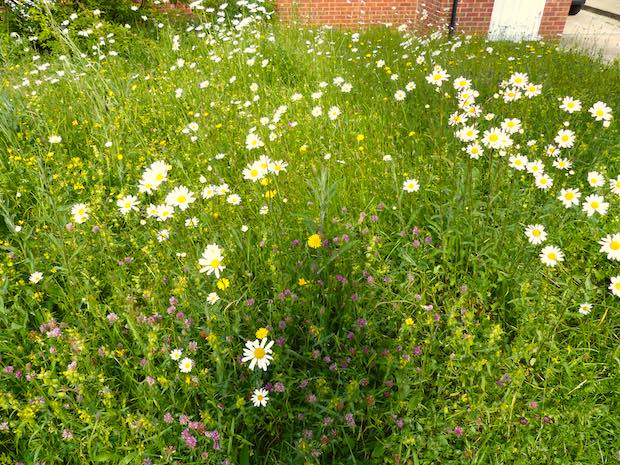
Yellow Rattle is now abundant, with Red Clover, Birdsfoot Trefoil and Cat’s Ear weaving through, here and there, like a beautiful tapestry, with some of the remaining Buttercups. There are also the sparkling, whorling small white flowers of Ribwort Plantain spread throughout.
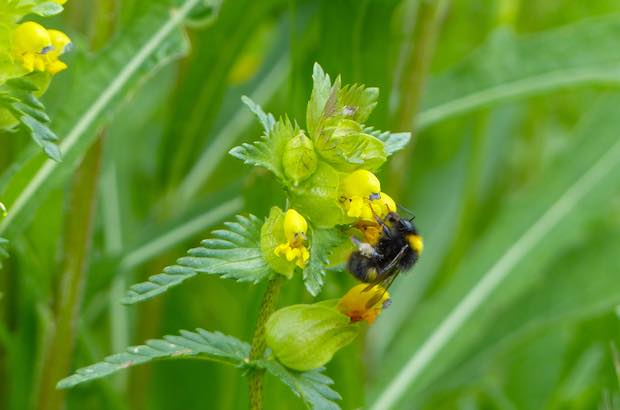
Bumble bees and solitary bees are now constantly visiting to drink nectar and take pollen from the wildflowers whilst damselflies patrol for insects. The meadow is really buzzing and it is heart-gladdening to watch these small beings taking the sustenance they need.
A neighbour recently said ‘It really looks like a proper meadow now!’ as we were stood nearby. My heart sang, as this is the first year it really does look like a wildflower meadow.
I enjoy each month for the changes they bring and look forward to visits from butterflies such as Meadow Brown, Ringlet, Small Skipper and hopefully, striking Marbled White. There may possibly even be some surprises, so watch this space!
Nature’s surprises
As I looked out of the window on the 8th June I spotted some pink flowers. Musk Mallow, I wondered? It was difficult to be certain in the early morning light. But, much to my delighted surprise it was Ragged Robin which was in the original seed mix (listed in the first article in this series). My next surprise was due to my own laziness in not looking closely enough. I assumed that a plant was a Meadow Buttercup which had been growing in that spot in the meadow last year. But, it was not. It is a Musk Mallow which was in that area, too, but has out-competed the Meadow Buttercup and is now 3 feet high. Their distinctive flower heads had made me realise my error, but they have not opened yet. The third surprise of the day was finding a Speckled Bush Cricket nymph on an unopened Small Scabious flower head.
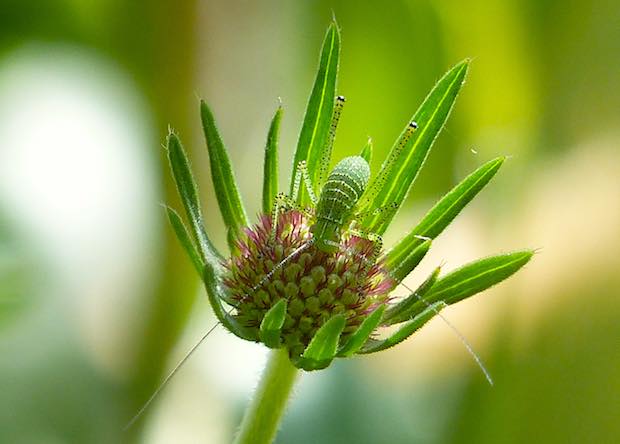
Amazingly, crickets can shed limbs that are grasped by predators and regrow them. It is called autonomy and they are able to do this because they go through successive moults until the adult stage when this ability ceases. They feed on the leaves and flowers of a variety of plants. It was a wonderful morning and I felt a real sense of well-being and quiet joy on finding Nature’s surprises.
More urban wildflower meadows are needed for pollinators
I could not have been more delighted when I read the following research results recently. A wildflower meadow really is beneficial to pollinators, even a mini one.
“As urbanisation is expected to increase in Europe over this decade, managing urban environments as important habitat for pollinators will become ever more relevant. Although the researchers appreciate that attention has been directed towards benefiting pollinators in agricultural environments in recent years, they suggest that more should be done to improve the quality of urban spaces for pollinators as well — this could include such measures as more trees and wildflower meadows in cities, leaving grass areas uncut, and pesticide-free small-scale urban agriculture.” Baldock et al – University of Bristol
Why is Poldark so popular?
The latest series in the BBC television drama ‘Poldark’ took the country by storm and became very popular overnight. I am sure that viewers were not only spellbound by handsome Ross Poldark and beautiful Demelza. They were subconsciously drawn to the evocative images of wildflower meadows being scythed and the unmown, wild landscapes and rugged coastline. This normal landscape appeals to the innate hunter-gatherer within us, in contrast to the mown, abnormal landscape that we see just about everywhere nowadays. Manicured, tidy landscapes are accepted by mindsets conditioned into seeing them as the ‘norm’ due to successful advertisements showing pristine lawns being mown and routing out those ‘horrible’ weeds with weed-killers, making it the only acceptable landscape in our ‘enlightened’ age. Yet the lawnmower was not invented until 1830 by Edwin Budding. Meadows used to be scythed and the grass needed to be tall enough to be able to scythe it. There was a traditional rhythm of allowing the grass to grow through spring and summer. Cutting the hay around mid-July or by Lammas Day (1st August) and then grazing the aftermath until November. As the hay was cut by farmers at different times between those dates, the mosaic of habitats meant that there was a diversity of wildflowers available for pollinators. What an amazing, vibrant, inspiring landscape it must have been.
We all need an intimate connection with natural landscapes for our mental and physical health and well-being. Not least for the planet’s. Ancient wildflower meadows are carbon sinks. So why not do your bit for the planet and wildlife by starting your own mini wildflower meadow in an unused lawn area? If you need advice there is a lot of information on our GET STARTED page. If you have already started one, do post your images on our Facebook and Twitter sites. We would love to see them!
Previous article in this series: Jo’s Mini Meadow 3

